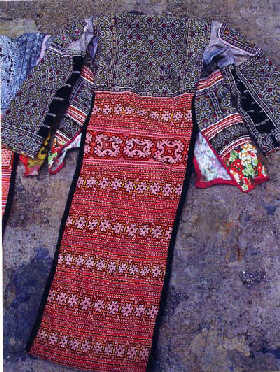Posted 2012/6/4
The Changjiao Miao people, who live in the mountainous region of Western Guizhou Province, were formerly a closed nation, and these days their culture still preserves some of its pre-industrial components.
Despite the fact that the Changjiao Miao people have developed rapidly in the industrial era, they have maintained many facets of their pre-industrial, agricultural lifestyles. Because they do not write with characters, a lot of their history is recorded orally and through the usage of their own figures. The figures were developed over time and helped the Changjiao Miao people record their own culture more permanently, facilitating communication over the generations.
Although figures aid in the transmission of Changjiao Miao people's culture, their oral histories,including songs, mythological tales and poems, are more detailed and developed.
Figure symbols
Most of the Changjiao Miao people's decorative symbols were integrated into their clothing, rather than adorning their tools or architecture, as is common in many other societies. The reason for this lies in the fact that the Changjiao Miao people were formerly a nomadic society, meaning that accumulating a large number of tools or constructing permanent buildings would have been pointless, since these things would have had to be left behind when the people moved.
Clothing was decorated as a way to preserve the people's history, in a format that was portable, as clothing would be taken when the group moved. Various symbols had different meanings, such as a square, which represented a field that had been ploughed; a stripe, which stood for a river that had been crossed; and various depictions of food they had eat en and tools they had used. These representations allowed the group to visibly wear the symbols of their common history and outlook on the world.
en and tools they had used. These representations allowed the group to visibly wear the symbols of their common history and outlook on the world.
Embroidery was a skill passed down from mothers to their young daughters, who were typically 6 years old when they started learning the craft. The people made most of their clothes themselves and the symbols were a medium for the communication of their world views. Modernization has meant that the traditional meanings of some of these symbols has been forgotten.
Sound symbols
In the Changjiao Miao people's society, oral history is a more dominant form of communication than written symbols, and it is mainly the domain of men.
Like the eastern Eskimos, who left behind few material possessions but a wealthy literary heritage, the Changjiao Miao people left behind few physical remnants but an abundant collection of songs and proses.

Some of their popular songs included Jiuling songs that were sung while people drank alcohol, Kailu songs that were sung while people led the way to somewhere, and Songke songs that were sung when people saw off their guests. Jiuling songs were sung in the ancient Miao tongue and had a rich historical content. Most of the songs were sung by men, and on occasions like marriages and funerals, those who were able to sing a complete series of Jiuling songs, were regarded as the most knowledgeable of the group.
"Cultural men"
A good deal of the Changjiao Miao people's heritage was preserved by so-called "cultural men," who were responsible for the transmission of oral history. They were expected to master certain skills, like singing different cultural songs, skills which were not shared by everyone in the group.